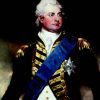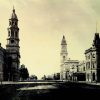The name of the central carriageway running north and south through the city of Adelaide was reserved for the King of England; the Street Naming Committee observing protocol and giving the principal street on the plan over to the monarch of the day.
The decision was not necessarily by personal or collective choice, nor made out of any sense of ideological empathy, for indeed unlike the majority of the Committee, the King of England was a Tory. Whoever reigned in Britain at the time of settlement was assured a place in South Australian history. With all east/west streets in Adelaide proper terminating at King William Street and no other street crossing it, the King’s thoroughfare takes royal precedence. There is a double irony to this in that King William IV’s time on the throne between 1830 and his death in 1837 coincided almost with the rise and fall of the Philosophical Radicals in the British House of Commons. This was a test for the Tory King, who could not abide radicals and didn’t exactly relish a government dominated by them. It is also especially poignant in that the majority of the streets on the Adelaide plan are deliberately named after radicals, most of them either Philosophical Radicals or liberal Whig parliamentarians of the day.
As the Street Naming Committee sat in their pise hut overlooking the River Torrens, they deferred to the King, gave meaning to the future reign of the young Princess Victoria in the central square and acknowledged the King’s choice of the name ‘Adelaide’ for the city by appending his name to the most central street on the plan.
At first the Committee aligned King William Street centrally in the city proper, but on an east/west axis. Presumably this was altered to a north/south orientation, more in keeping with the placement of the Government House compound, then sketched right across the end of the road and facing onto North Terrace. The most easterly face of the Old Parliament House is probably the boundary of the original Government House compound, and it may have also encompassed part of today’s Adelaide Festival Centre area complex. Today, King William Street is an impressive thoroughfare only broken by Victoria Square, which sits plumb in the centre of the quincunx of the city of Adelaide proper.
William Henry was the third son of George III and was born on 21 August 1765. He joined the Royal Navy at 13 and became the Duke of Clarence of England, the Duke of St Andrews of Scotland and the Earl of Munster of Ireland, all in 1789. These honours were merged when, on the death of his brother George IV on 26 June 1830, he became King of the United Kingdom of Great Britain, Ireland and Hanover.
Succeeding to the monarchy as the most likely one to produce a future heir – especially after George IV, the oldest son, had lost both Princess Charlotte and a brother in childbirth – the focus shifted to brother William. He had sired many other children illegitimately and so he married Princess Adelaide of Saxe-Meiningen, sight unseen, on 11 July 1818 at Kew Palace. It is indeed a sad irony that Queen Adelaide then bore but lost her only two children.
By the time William was named in the streets of Adelaide he was in his declining years. He had enjoyed twenty years of conjugal bliss, albeit in the defacto sense, with Mrs Jordan, with whom he fathered ten bastard children, before discarding her to posterity. Thereafter, he was happily married to his young, steadfast, conservative and devoted Queen Adelaide.
Those on the Street Naming Committee who knew the King either personally or at a distance might have described him as a country squire, in his late 60s with not too many airs and graces. In appearance he was remarkably ordinary except for the shape of his head, which resembled a pineapple. He was a portly man of 170cm (5 feet, 7 inches) – ‘a little old, red-nosed, weather-beaten, jolly-looking person, with an ungraceful air and carriage’. He entertained incessantly, usually at least 2,000 people a week, where he was exceedingly generous without being extravagant.
His reign was said to be one of ‘informality, economy and patriotism’, and he would frequently regale his guests with tiresome, boring speeches. He was nevertheless a vast improvement on his late brother, King George IV, who was so profligate that in one year alone 36,000 bottles of wine were drunk at St James’ Palace. King William detested formality. He was bored by horseracing, disdainful of all art, especially paintings of religious objects, which he thought should be destroyed, and contemptuous of writers, especially journalists. A few of his notably bad habits were to fall asleep in the royal box at the opera, spit on impulse from his carriage and to sometimes wipe his nose with the back of his forefinger. This somewhat boorish provincial behaviour, conjoined with a good dollop of affability, was perhaps what endeared him to the English public. Especially as it was such a change from the snivelling excesses of his older brother, who disenchanted the public during his reign that the monarchy fell into disrepute. William turned all that around, and with the help of his devoted Queen, the public was once again in favour of the monarchy by the time he died in 1837.
Historically, William’s seven years as King were not considered to be particularly momentous. It was a short reign, which sat squarely between the dominant Georgian period throughout which successive Tory governments held power and the long and glorious reign of Queen Victoria, during which party lines gradually became more distinct. In a South Australian context, however, this was crucial, for it encompassed some of the most sweeping changes ever to Britain’s electoral system, which in turn smoothed a pathway for revolutionary legislation on colonisation. It was a time when William was forced to steer the monarchy through tricky shoals of social upheaval and electoral change. He also had to work with at least two ministries that did not fit squarely with his private political views and which could be described as idiosyncratic, since they were formed within his rather limited social circle.
Some writers claim that William IV’s most intimate society was distinctly right wing at the point of reform. Privately he was both anti-Semitic and a supporter of the slave trade, although this latter point was never exposed to public scrutiny.
For those familiar with the imposing nineteenth-century buildings on King William Street in Adelaide, the most telling thing about William IV is that the South Australian experiment materialised during his reign and on his watch.
King William exercised his already limited powers with extreme caution. His mind was in turmoil over the demand to create extra peerages. When it became likely that the Reform Bill would pass the Commons it was forecast that the Act would be lost in the Lords for want of ‘liberal’ support.
If the King didn’t acquiesce on the creation of enough peerages to balance the Upper House, the Bill was bound to be lost and there would be further outrage throughout the kingdom. He made it clear he was not in favour of election by ballot and he was even more rancorous towards the idea of universal suffrage. But he knew that some electoral change was unavoidable. In the end, and under pressure from people like Lord Brougham, he reluctantly agreed to create fifty new peers. This injected some party political balance into both Houses of Parliament and the Reform Bill finally passed into law.
When King William came to the throne in 1830 the Tories were in power and he immediately joined the Duke of Wellington in tandem, in what he thought would be an easy ride. The two were inseparable. When the Duke lost power to Grey’s Whig government in August 1830, the King found Grey to be measured in his call for reform, dignified and aristocratic in bearing and a wonderful orator in the House.
By the time the first South Australian colonists sailed from England, William’s health was showing signs of rapid decline. His body was racked by frequent bouts of asthma and those at court thought him frail. Nevertheless, one last matter niggled at him. It revolved around the protracted antipathy between himself and the Duchess of Kent. The antipathy between the King and his sister-in-law had simmered for years and William was most displeased that the young Princess Victoria had been withheld from the public so much by her mother. He was so incensed by the Duchess’ behaviour that he intemperately launched into a public outburst at his birthday celebration in August 1836.
William IV’s brief time in the sun came to an end in July 1837 and he passed from history with hardly any afterthought. Some say he went without much more than a cursory acknowledgement, even though he was waved goodbye with an inordinate amount of pomp and circumstance.







Comments